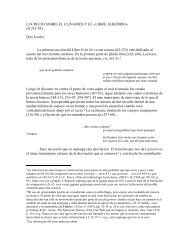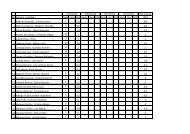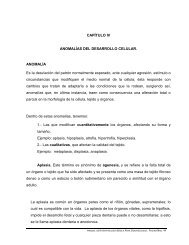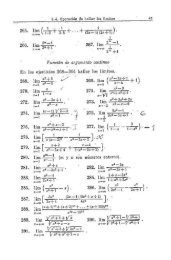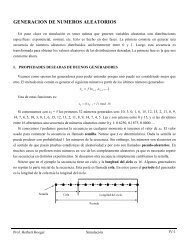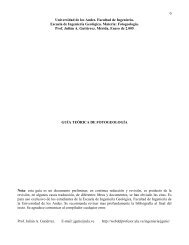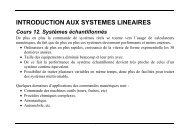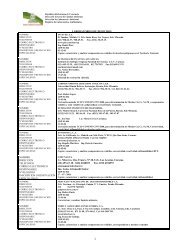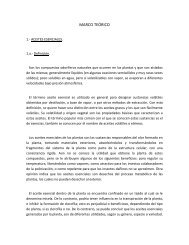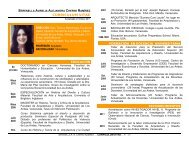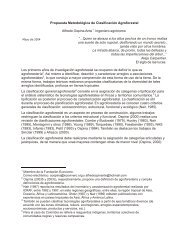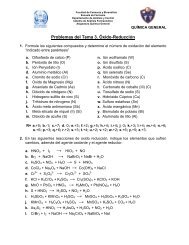Diagramas de Tanabe-Sugano y de Orgel - Web del Profesor ...
Diagramas de Tanabe-Sugano y de Orgel - Web del Profesor ...
Diagramas de Tanabe-Sugano y de Orgel - Web del Profesor ...
You also want an ePaper? Increase the reach of your titles
YUMPU automatically turns print PDFs into web optimized ePapers that Google loves.
Química Inorgánica 2 / Prof. Ricardo Rafael Contreras<br />
<strong>Diagramas</strong> <strong>de</strong> <strong>Tanabe</strong>-<strong>Sugano</strong> para las distintas configuraciones electrónicas y geometrías octaédricas<br />
d 2 ; C/B = 4,42 d 3 ; C/B = 4,5<br />
Universidad <strong>de</strong> Los An<strong>de</strong>s<br />
1
<strong>Diagramas</strong> <strong>de</strong> <strong>Tanabe</strong>-<strong>Sugano</strong> (Continuación)<br />
Química Inorgánica 2 / Prof. Ricardo Rafael Contreras<br />
d 4 ; C/B = 4,61 d 5 ; C/B = 4,48<br />
Universidad <strong>de</strong> Los An<strong>de</strong>s<br />
2
<strong>Diagramas</strong> <strong>de</strong> <strong>Tanabe</strong>-<strong>Sugano</strong> (Continuación)<br />
d 6 ; C/B = 4,8 d 7 ; C/B = 4,63<br />
Química Inorgánica 2 / Prof. Ricardo Rafael Contreras<br />
Universidad <strong>de</strong> Los An<strong>de</strong>s<br />
3
<strong>Diagramas</strong> <strong>de</strong> <strong>Tanabe</strong>-<strong>Sugano</strong> (Continuación)<br />
d 8 ; C/B = 4,71<br />
Química Inorgánica 2 / Prof. Ricardo Rafael Contreras<br />
Universidad <strong>de</strong> Los An<strong>de</strong>s<br />
4
Química Inorgánica 2 / Prof. Ricardo Rafael Contreras<br />
Tabla 1: Valor <strong>de</strong>l <strong>de</strong>sdoblamiento <strong>de</strong> campo cristalino Δ (en kK) <strong>de</strong>rivado <strong>de</strong> los espectros <strong>de</strong> absorción electrónica <strong>de</strong><br />
complejos octaédricos y tetraédricos con distintos tipos <strong>de</strong> ligandos *<br />
Número <strong>de</strong><br />
electrones<br />
“d”<br />
Ion<br />
Metálico<br />
6F<br />
6Cl<br />
6Br<br />
6H2O<br />
1 Ti(III) - 13 - 20 - 17 - - -<br />
2 V(III) 16 13 - 19 18 18 - - -<br />
3 Cr(III) - 13 - 17 17 22 22 26 -<br />
“ Re(IV) 32 33 - - - - - - -<br />
4 Cr(II) - 13 a - 14ª - - 18ª - -<br />
“ Mn(III) 22 a 20ª - 21ª - - - 30 b -<br />
5 Mn(II) 8 8 - 8 - - 10 - 2<br />
“ Fe(III) 14 - - 14 14 - - 35 b 5<br />
6 Fe(II) - - - 10 - - - 33 b 4<br />
“ Co(III) 13 c - - 19 18 24 24 34 -<br />
“ Rh(III) - 20 19 27 26 34 35 - -<br />
“ Ir(III) - 25 23 - - - 41 - -<br />
“ Pt(IV) 33 29 25 - - - - - -<br />
7 Co(II) - - - 10 11 11 11 - 3,2<br />
8 Ni(II) - 7 6 9 - 11 12 - 3,5<br />
9 Cu(II) - - - 13ª - 15ª 16ª - -<br />
a El valor afectado <strong>de</strong> una elongación tetragonal <strong>de</strong>l complejo octaédrico.<br />
b Complejos <strong>de</strong> bajo espín.<br />
c Complejos <strong>de</strong> alto espín.<br />
* Adaptado <strong>de</strong>: Figgis B., Hitchman MA. (2000). and, Ligand Field Theory and its Applications. New York: Wiley-VCH.<br />
3Ox<br />
6NH3<br />
3en<br />
6CN<br />
4Cl<br />
Universidad <strong>de</strong> Los An<strong>de</strong>s<br />
5
Química Inorgánica 2 / Prof. Ricardo Rafael Contreras<br />
Tabla 2: Valores seleccionados <strong>de</strong> los parámetros <strong>de</strong> Racah (B y C) <strong>de</strong> complejos <strong>de</strong> metales <strong>de</strong> transición octaédricos<br />
acuosos que pue<strong>de</strong>n ser utilizados con aproximación para trabajar con los diagramas <strong>de</strong> <strong>Tanabe</strong>-<strong>Sugano</strong>.<br />
d n B (cm -1 ) C/B d n B (cm -1 ) C/B d n B (cm -1 ) C/B d n B (cm -1 ) C/B<br />
d 2 886 4,42 d 4 796 4,6 d 6 1.080 4,42 d 8 1.042 4,71<br />
d 3 933 4,5 d 5 859 4,48 d 7 986 4,63<br />
Universidad <strong>de</strong> Los An<strong>de</strong>s<br />
6
Tabla 3: Valor <strong>de</strong>l parámetro <strong>de</strong> Racah B para algunos complejos típicos * .<br />
Química Inorgánica 2 / Prof. Ricardo Rafael Contreras<br />
Complejo Configuración “d” Simetría B (cm -1 ) Complejo Configuración “d” Simetría B (cm -1 )<br />
[VF6] 3- d 2 Oh 627 [FeBr4] 1- d 5 Td 470<br />
[VCl6] 3- d 2 Oh 536 [Fe(CN)6] 4- d 6 Oh 490<br />
[VCl4] 1- d 2 Td 505 [CoF6] 3- d 6 Oh 787<br />
[V(NH3)6] 3+ d 3 Oh 660 [Co(NH3)6] 3+ d 6 Oh 615<br />
[CrF6] 3- d 3 Oh 896 [Co(CN)6] 3- d 6 Oh 400<br />
[CrCl6] 3- d 3 Oh 512 [Co(NH3)6] 2+ d 7 Oh 885<br />
[Cr(NH3)6] 3+ d 3 Oh 657 [Co(NH3)4] 2+ d 7 Td 710<br />
[MnF6] 2- d 4 Oh 650 [CoCl4] 2- d 7 Td 710<br />
[MnCl4] 2- d 5 Td 650 [CoBr4] 2- d 7 Td 695<br />
[MnBr4] 2- d 5 Td 630 [CoI4] 2- d 7 Td 665<br />
[FeF6] 3- d 5 Oh 835 [Ni(NH3)6] 2+ d 8 Oh 881<br />
* Adaptado <strong>de</strong>: Figgis B., Hitchman MA. (2000). and, Ligand Field Theory and its Applications. New York: Wiley-VCH.<br />
Universidad <strong>de</strong> Los An<strong>de</strong>s<br />
7
<strong>Diagramas</strong> <strong>de</strong> <strong>Orgel</strong> *<br />
Complejo octaédrico d 2<br />
* Las líneas continuas representas los niveles triplete y las líneas punteadas los niveles singlete.<br />
Química Inorgánica 2 / Prof. Ricardo Rafael Contreras<br />
Universidad <strong>de</strong> Los An<strong>de</strong>s<br />
8
<strong>Diagramas</strong> <strong>de</strong> <strong>Orgel</strong><br />
Complejos octaédricos y tetraédricos:<br />
d 2 , d 3 , d 7 y d 8 , espín libre.<br />
Química Inorgánica 2 / Prof. Ricardo Rafael Contreras<br />
Universidad <strong>de</strong> Los An<strong>de</strong>s<br />
9
Diagrama <strong>de</strong> <strong>Orgel</strong><br />
Complejo octaédrico d 5 , espín libre.<br />
Química Inorgánica 2 / Prof. Ricardo Rafael Contreras<br />
Universidad <strong>de</strong> Los An<strong>de</strong>s<br />
10



